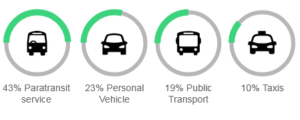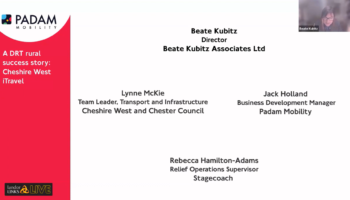75% of paratransit users are unsatisfied with the current state of paratransit services, a survey by Padam Mobility has revealed. Find out what People with Reduced Mobility really expect from a barrier-free mobility and how to achieve it.
Over 14 million People with Reduced Mobility live in the UK. 12 million in France, and 8 million with severe disabilities in Germany. More than 90 % are using public transport. Public authorities and transit operators need to adjust their services to make it fair and easy to use for everyone.
“Paratransit services are a rigid and restrictive system which prohibits any spontaneity”
Why users are unsatisfied with paratransit services
We polled people with mobility impairments. While the majority is using transportation at least twice a week, more than 60% depend on the schedule of the public service to plan their daily life. And independence comes at a high cost – with an expensive adapted car, or a taxi.
Very often, paratransit services will also require planification 24h in advance.
Public schedules make it hard to avoid long waiting times, too early pick-ups or late drop-offs. Since more than 70% need to travel to different destinations or at different times every day, the transportation offer needs to be more flexible.
Here is a dropdown of the most used means of transportation in the population we surveyed

Paratransit services are the main solution, but have a lot of room for improvement.
“Paratransit takes me too long to wait. I have to be ready 30 minutes before the booking and wait another 30 minutes before the vehicle arrives”
This is why 75% of paratransit users are unsatisfied with the current state of paratransit services.
The second major need to consider is accessibility. On top of accessible bus stops and vehicles, booking a ride can also be a challenge for People with Reduced Mobility. Most of the services are not digitised and thus cannot take into account additional dwelling times for wheelchair users when booking a ride. A digital booking solution will take this into account, and to make the service more efficient and user-friendly.
Last but not least, security and comfort is a third need that users with reduced mobility wish to see addressed. Traveling together with caregivers or companions, and having a dedicated seat for them can be essential.
Here are the 6 main issues paratransit users have finally shared with us
- Lack of spontaneity
- Lack of flexibility
- Loss of time (vehicle delay / trip with many detours)
- Poor accessibility
- Stress related to delay and space in the vehicle
- Dependence on a third party
Dynamic DRT for paratransit users
Demand-Responsive Transport (DRT) offers an opportunity to create barrier-free public transport: it focuses on its users rather than the schedule. Since over 70% People with Reduced Mobility live in suburban areas, DRT allows a door-to-door service with barrier-free vehicles. With the booking options such as selecting a number of wheelchair seats and enabling booking by third parties, transit operators can increase the quality of their paratransit service without causing tremendous operating costs.
Example of dynamic DRT features that address issues for People with Reduced Mobility:
| Real-time booking | Allows more spontaneity, rides can be booked less than 30 min in advance |
| Dynamic schedules based on the demand | Allows more flexibility |
| Real-time notifications on the vehicle approach | Avoids long waiting times at pick-up stops |
| Booking by a third-party | Allow caregivers or companions to take care of the paratransit users’ mobility when their situation does not allow them to book a ride directly |
| Door-to-door service | Improves accessibility drastically |
| Specific dwelling time per user or user type | Improves the reliability of the service by taking into account the amount of time necessary to pick-up and drop-off a user, depending on his specificity |
| Additional information on users | Allows the service to fit the users’ specific needs thanks to useful information shared with operators and drivers |
| Additional information on equipments | Ensures the vehicles are adapted to onboard any specific equipment (wheelchairs, etc.) |
In cooperation with transport operators, Padam Mobility provides a response to the mobility and digitalisation challenges of paratransit services and stakeholders. Smart shared mobility services allow users to book their rides in real-time, as well as vehicles that have space for a wheelchair or baby carriage. Therefore, the transport service becomes more accessible and flexible for everyone.
Padam Mobility powers the software behind paratransit services in Brittany (BreizhGo), in Pays-de-la-Loire (Aléop), in Le Pays de Saint-Omer (Mouvéo), Limoges (RRTHV), Chalons-en-Champagne (Sitac), in Pays-du-Mont-Blanc (Montenbus) and in the Landes department (Oé à la demande).
On these services, the most important and popular features are the door to door service, the additional information on users and the ability to adapt dwelling times for pick-up and drop-off depending on the user’s specificities.


Are you operating a paratransit service? What are the major pain points or users are addressing? Comment this article and share our thoughts and opinions with us!
These articles may be of interest to you:
Is Demand-Responsive Transport relevant in urban areas?
Find out more about Padam Mobility’s Paratransit offer here.





